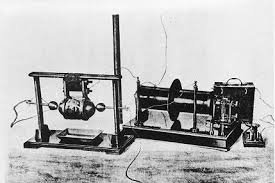Transmitter improvements
Guglielmo Marconi

Transmitter improvements
Early transmitter technology used a spark discharge connected to an aerial to provide the signal. Today this seems a particularly crude form of radio communications technology. Marconi had noted that the technology had been in use for a number of years and needed improving to ensure the continued development of the overall radio communications technology.One of the key issues was that once the spark was struck, and remained conductive, the radio frequency energy created by the spark transferred from the spark circuit to the antenna and back many times with much of the RF energy being absorbed in the spark rather than being radiated.In addition to this the signal was very broadband in nature and also gave a very rough sound in the operators headphones.To improve the overall efficiency of these early radio communications transmitters, Marconi invented a system whereby the spark was struck and extinguished in a more controlled manner using a studded disc to vary the length of the spark.
As each stud on the wheel came towards the stationary electrode, the gap narrowed and the spark struck. As it then moved away the length of the spark increased and eventually it extinguished.This development or invention had a number of advantages. Firstly, the signal received by the operator had a far more musical note and was easier to copy. Secondly the extinction of the spark was timed to occur as the reflected power was returned from the aerial circuit. As the oscillations from the spark were unable to return to the now extinguished spark, the oscillations reduced slowly increasing the efficiency and also reducing the signal bandwidth.The result was that Marconi introduced the system onto his transatlantic transmitters in 1907 thereby increasing the reliability, although in reality, messages often needed to be transmitted several times to prevent errors.
 Test your English Language
Test your English Language  Benefits of Saffron
Benefits of Saffron Management Tips
Management Tips Benefits of Ugli fruits
Benefits of Ugli fruits Benefits of Tomatoes
Benefits of Tomatoes




